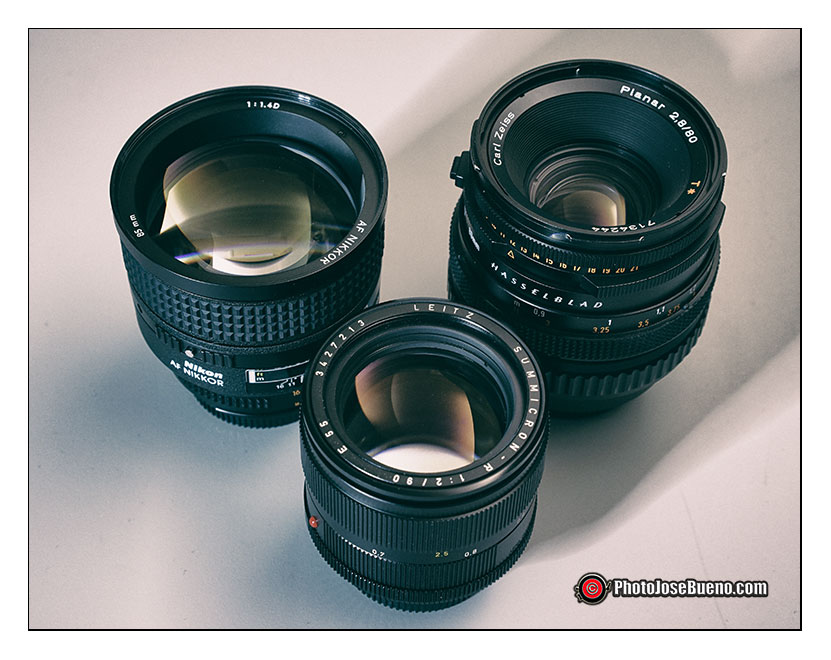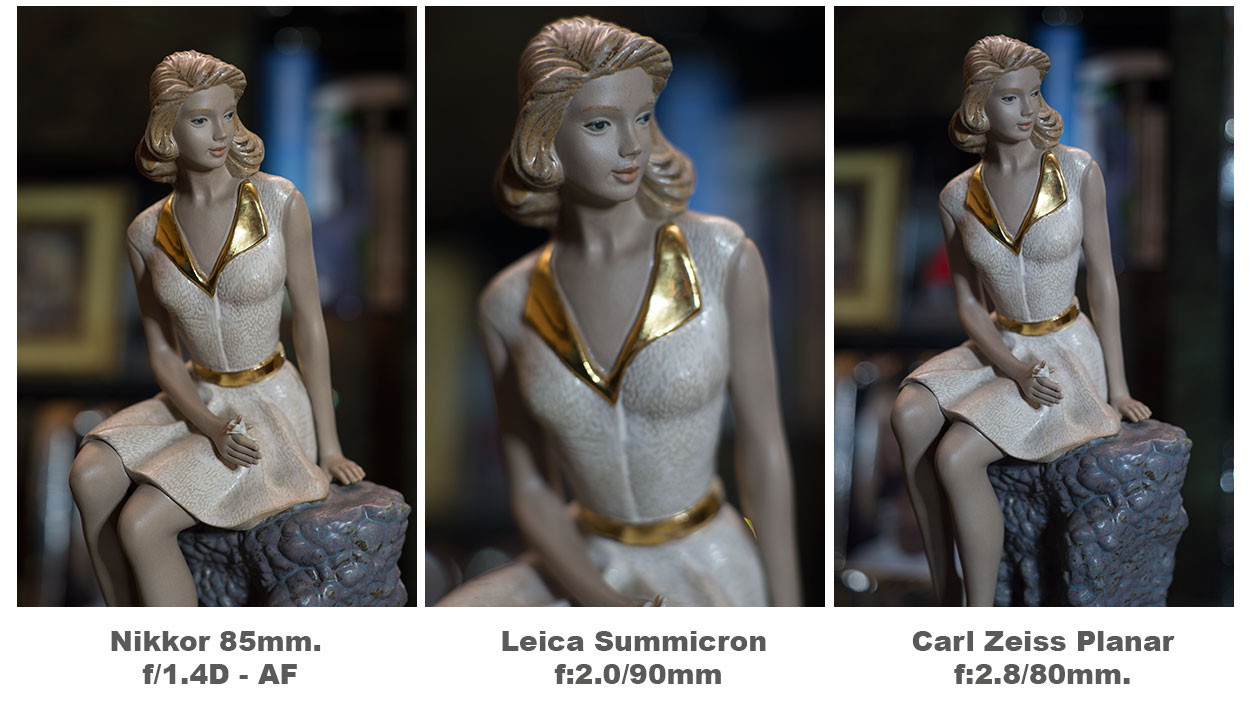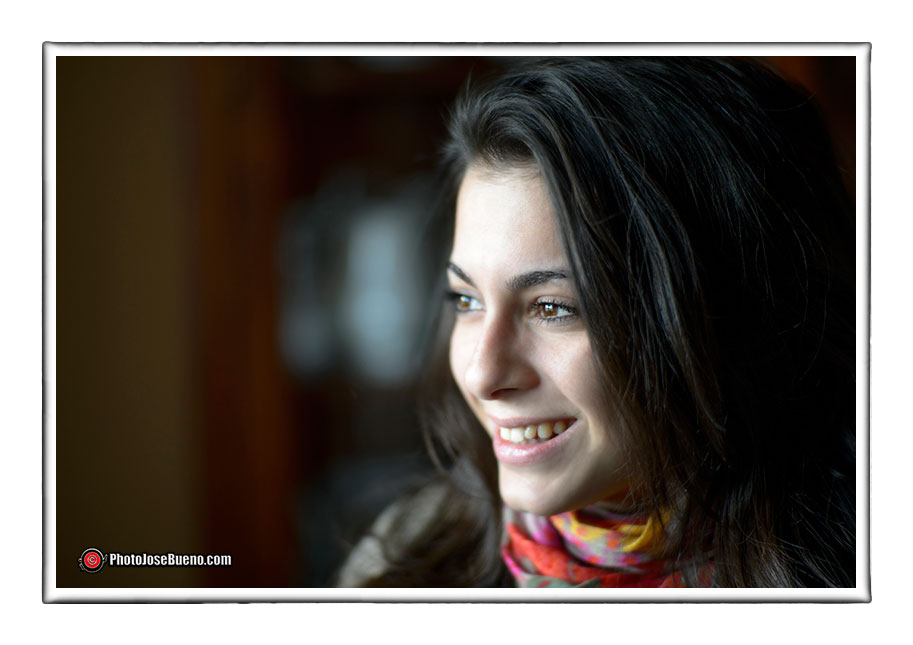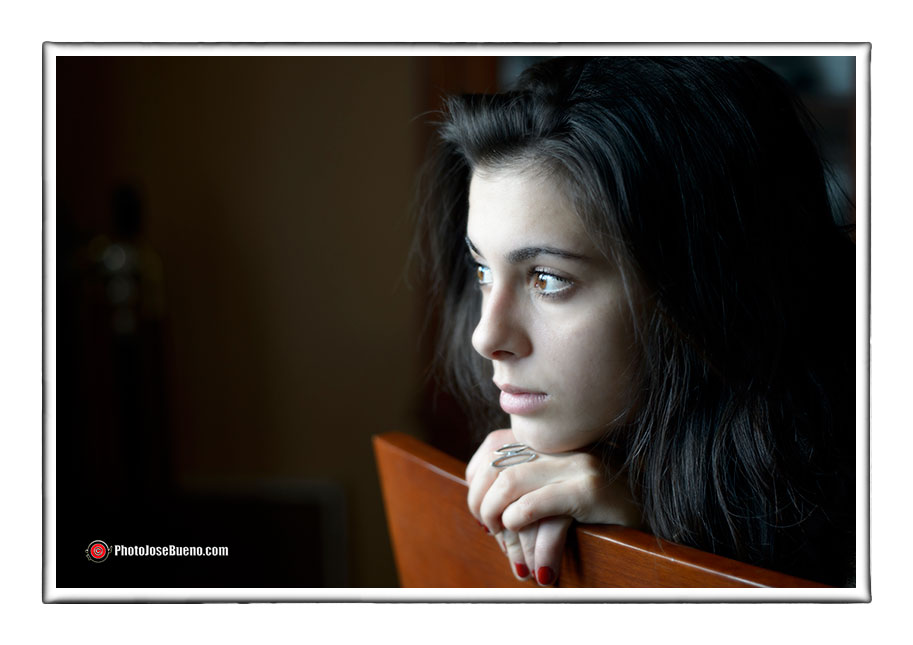
Cuando hablamos de teles cortos me estoy refiriendo a focales de 80 a 100mm. Este tipo de teleobjetivos son codiciados por los fotógrafos especialistas en el retrato, pero …, estos objetivos sirven para más cosas? , cual es la más recomendable? , mejor manual o autofoco? .
Trataremos de resolver estas y otras preguntas que puedan surgir, probando en esta entrada tres auténticas “patas negras”, nada menos que el Nikkor 85mm. f:1.4 autofoco, el Leica Summicron-R 90mm. f:2.0 y el Carl Zeiss 80mm. f:2.8 que fue diseñado para la Hasselblad del sistema V. Estos dos últimos son manuales y en el caso del Leica se cambió la bayoneta para montura Leica R por una bayoneta Nikon y en el caso del Carl Zeiss utilizaremos un adaptador que permite colocar este excelente objetivo en mi Nikon D4.
Mi experiencia en el uso de estas tres ópticas, me dicen que para trabajos en objetos con movimiento, el autofoco es imprescindible y para trabajos más relajados del tipo bodegón, las ópticas manuales son geniales. También es cierto que en este aspecto el Nikkor 85mm. tiene ambos sistemas ya que permite el autofoco y también podemos trabajar en manual.
Antes de comenzar la prueba y analizar los resultados, tengo que decir que mi cabeza tiene preconcebidas ciertas ideas como que el efecto 3D formado por enfoque y desenfoque, el Zeiss Planar es inigualable. También pienso que el Leica Summicron es el mejor en color y el Nikkor es el rey de la definición. ¿Serán ciertas estas ideas que rondan en mi cabeza?, vamos a ello.
Empecemos por el tema datos que en mi opinión pueden decidir una compra:
Enfoque mín. Peso Máx. Apertura
Carl Zeiss Planar 80mm. 2.8 0,90 m. 510 g. f:2.8
Leica Summicron-R 90mm. 2.0 0,68 m. 560 g. f:2.0
Nikkor 85mm. 1.4D 0,85 m. 560 g. f:2.8
Efectivamente hay gente que se fija en la luminosidad o en el peso o en otros datos técnicos o de marca a la hora de elegir un objetivo.

En mi caso, un dato que suelo valorar mucho ya que lo considero muy importante tanto si hacemos retrato como si queremos hacer bodegón, es la distancia mínima de enfoque. No es necesario que sea macro pero cuanto más cerca enfoque más fácil será trabajar con ese objetivo además que en algunas ocasiones y para determinadas fotos, esto se agradece para conseguir mejores desenfoques, junto con la ayuda de la máxima apertura y en este caso no me estoy refiriendo al bucket.
En este apartado el rango de enfoque del Carl Zeiss Planar es de 0,9 metros lo que le convierte en la peor opción si queremos invadir a nuestra modelo con el objetivo. Ello también afecta a otros factores como los desenfoques.

Nikon D4 – Nikkor 85 f:1,4 D
1/250s – f:1.4 – ISO 400
El Nikkor 85mm. 1.4D tampoco es que sea muy generoso con esta distancia mínima pues tan solo nos permitirá acercarlos al primer plano enfocado a 85 centímetros., algo que no mejora en exceso la cifra del Zeiss.

Nikon D4 – Leica Summicron R-90mm.
1/200s – f:2.0 – ISO 400
Otro tema es el Leica Summicron R-90 que sin ser un objetivo macro, si que nos permitirá un acercamiento hasta los 68 centímetros y ello se nota en mucho tipo de fotografías que queramos realizar. Eso sumado a que es la focal con más tele permite un mayor acercamiento lo que tiene sus ventajas siempre y cuando juguemos con otros elementos como sus aperturas. En concreto este tiene una f:2.0, en mi opinión suficiente para retrato ya que el f:1.4 del Nikkor se me antoja demasiado crítico a la hora de enfocar y el f:2.8 del Zeiss como apertura máxima en una óptica fija es algo, .. bueno no está mal pero me gusta más el f:2.0 del Leica Summicron. Es cierto que con todas estas aperturas, hoy en día vamos sobrados de luz y es quizás otros temas como la definición, dureza, suavidad, color etc. lo que hará que una óptica nos guste más o menos para cada trabajo. Además la mayor apertura se traduce en mayor tamaño y mayor peso, claro que todo dependerá por ejemplo de la calidad de materiales de construcción. Todos los que aquí hemos probado son pesados pero hechos para durar en el tiempo.
En mi caso la comodidad de trabajar con el autofoco en trabajos en los que el motivo principal está en movimiento como una modelo, o un coche, me resulta imprescindible el Nikkor AF.
A la hora de hacer algo tipo bodegón en estudio y si quiero acercar mucho la cámara al primer plano, el Leica Summicron es excelente. Sus desenfoques y colores apenas necesitan tratamiento de post producción y eso también es un dato importante.

Nikon D4 – Carl Zeiss Planar 2.8/80mm.
1/125s – f:2.8 – ISO 400
El Zeiss me encanta en aquellos paisajes en lo que necesito una definición “dulce”. También es una óptica con un alma especial pues en algunos diafragmas su diferencia de contraste entre el centro y extremos lo hacen en eso que yo llamo “especial”.
Quizás mi opinión no te ayude a tomar una decisión si quieres comprar un tele corto pero si me permites un consejo lo mejor es que pruebes la óptica en lo que más lo vas a utilizar.
Marching a short teles
When we talk about short teles I am referring to 80 to 100mm focal. This type of telephoto lenses are coveted by specialists in portrait photographers, but … These goals are for more? , Which is the most recommended? Better manual or autofocus? .
Try to resolve these and other questions that may arise, proving in this post three authentic «black feet», nothing less than the Nikkor 85mm. f: 1.4 autofocus, the Leica Summicron-R 90mm. f: 2.0 and 80mm Carl Zeiss. f: 2.8 that was designed for the Hasselblad V system latter two are manual and in the case of Leica bayonet mount was changed to a Nikon Leica R bayonet and in the case of Carl Zeiss use an adapter that allows placing this excellent lens on my Nikon D4.
My experience in the use of these three approaches, I say to work on moving objects, autofocus is essential and more relaxed type of still life works, hand lenses are great. It is also true that in this respect the Nikkor 85mm. have both systems because it allows autofocus and we can also work in manual.
Before starting the test and analyze the results, I have to say that my head has certain preconceived ideas like the 3D effect formed by focusing and defocusing, the Zeiss Planar is unmatched. I also think the Leica Summicron is the best in color and Nikkor is the king of the definition. Will some of these ideas in my head hovering ?, let’s do this.
Let’s start with the data subject which in my opinion can decide a purchase:
Focus min. Weight Max. opening
Carl Zeiss Planar 85mm 2.8 0.90 m. 510 g. f: 2.8
Leica Summicron-R 90mm. 2.0 0.68 m. 560 g. f: 2.0
Nikkor 85mm. 1.4D 0.85 m. 560 g. f: 2.8
Indeed there are people who are still in brightness or weight or other technical or brand when choosing a target data.
In my case, a figure that usually appreciate a lot because I consider it very important whether we portrait as if we do still life, is the minimum focusing distance. No need to be macro but the closer approach easier it will work with that goal in addition that sometimes, for certain photos, this is appreciated for better blurs, along with the help of the maximum opening and in this case I I am referring to the bucket.
In this section the focus range of the Carl Zeiss Planar is 0.9 meters which makes it the worst choice if we invade our model with the target. This also affects other factors such as blurs.
The Nikkor 90mm. D is also to be very generous with the minimum distance just because it will allow us closer to the foreground in focus to 85 cm., Which does not improve over the figure of Zeiss.
Another issue is the Leica Summicron R-90 without a macro lens, if we allow an approach to 68 inches and this is evident in much kind of pictures you want to make. That added to which is the more tele focal allows closer which has its advantages as long as we play with other elements and their openings. In particular it has a f: 2.0, in my enough to portrait view as the f: 1.4 Nikkor strikes me as too critical when focus and f: 2.8 Zeiss as maximum opening in a fixed optics is something, well .. not bad but I like the f: 2.0 Leica Summicron. It is true that all these openings, today we sobrados light and perhaps other issues such as the definition, hardness, softness, color etc. which will make us more like an optical or less for each job. Moreover greater openness results in larger and heavier, of course it all depends eg quality building materials. All we have here tried are heavy but made to last in time.
In my case the convenience of working with Autofocus in jobs where the main subject is moving like a model, or a car, it is imperative me the Nikkor AF.
When do something kind still life studio and if I want to get very close to the foreground camera, the Leica Summicron is excellent. Your blurs and colors just need treatment in post production and that is also an important fact.
The Zeiss love in those landscapes that I need a «sweet» definition. It is also a scope with a special soul as in some diaphragms their difference in contrast between the center and ends do in what I call «special».
Maybe my opinion will not help you make a decision if you want to buy a short tele but if you allow me the best advice is to try optics in what’s going to use.